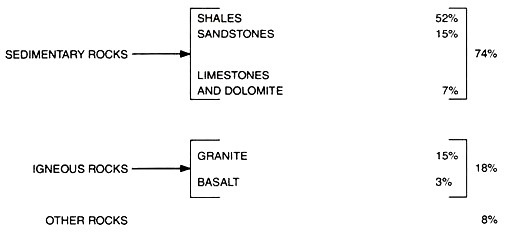ADVERTISEMENTS:
After reading this article you will learn about:- 1. Meaning of Rocks 2. Occurrence of Soil Forming Rocks 3. Classification.
Meaning of Rocks:
The rocks which form the earth are made up of minerals. Rocks may be defined as the mixtures of two or more minerals. So their physical and chemical compositions vary with the characteristics of the minerals. Petrology is the science of rocks which form the units of the earth’s crust. It consists of petrography—deals with the description of rocks and pedogenesis— study of the origin of rocks.
Occurrence of Soil Forming Rocks:
On the basis of their genesis and structure, rocks are generally grouped into three classes, namely:
ADVERTISEMENTS:
(i) Igneous,
(ii) Sedimentary and
(iii) Metamorphic.
The composition of the upper 5 km of the earth’s crust is as follows:
So it is found that five kinds of rocks mentioned above occupy more than 90% of the total continental area. However, composition of earth’s crust as a whole differs significantly.
Classification of Rocks:
1. Igneous Rocks:
They are formed by solidification of molten material magma on or beneath the surface of earth. They are characterized by non-laminar massive structure and on whole, make up 95% of the earth’s crust. During volcanic eruptions, which are brought about by increased pressure of the earth due to some geological changes, molten mass or lava is forced out to the surface of the earth.
2. Sedimentary Rocks:
ADVERTISEMENTS:
They are formed from the consolidation of sediments derived from the breaking down of pre-existing rocks. The sediments are transported to new places through wind or water action and deposited in new arrangements and cemented to form secondary rocks. Stratification is the most common feature of these rocks and so these are also termed as stratified rocks.
They are formed through four stages i.e:
(i) Weathering
ADVERTISEMENTS:
(ii) Transportation,
(iii) Deposition and
(iv) Di-agenesis—transformation of unconsolidated sediments to hard rocks.
Based on their origin, the sedimentary rocks are grouped into two main classes.
ADVERTISEMENTS:
3. Metamorphic Rocks:
Metamorphic rocks may be defined as those which have undergone some chemical or physical change from its original form. They are formed from the subsequent transformation of igneous and sedimentary rocks under the influence of chemically active liquids and gases and internal heat and pressure.
The structure and mineral composition of metamorphic rocks depends on the constituents of the original rocks and the kind of metamorphism. There are two broad classes of metamorphism viz. thermal—changes bring about by dominant factor heat and dynamo thermal—changes bring about by the combined effect of pressure and heat.
Some common metamorphic rocks are as follows:
1. Gneiss (Pronounced “nice”):
Light-coloured igneous rocks with minerals segregated and oriented to form light and dark bands (Formed mostly from granites, rhyolities, andesites and other similar minerals).
2. Schist:
Fissile or foliated (flaky or layered) composed of many rocks or minerals, particularly mica called mica schists. Mica schists weather rapidly through the laminous cleavages, giving rise to soil high in vermiculite and quartz.
3. Slate:
Hardened shale or siltstone or mudstones containing fine grained rocks high in mica and quartz.
4. Quartzite:
Recrystallized quartzitic sandstone, formed by the action of heat and pressure. Very slow to weather and produces shallow light textured sandy soils. It is extremely resistant to weathering.
5. Marble:
Limestone or dolomite hardened enough to polish, frequently coloured by inclusions of various other minerals and resistant to weathering.

